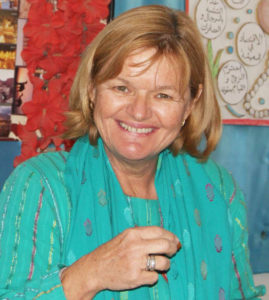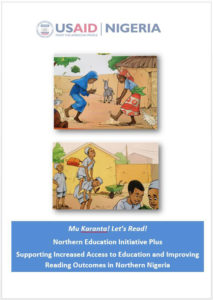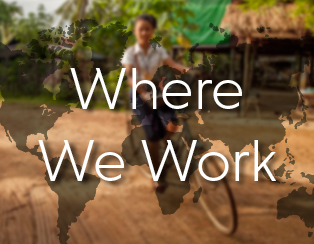Reading expert shares the power of illustrations to encourage literacy
By Natalie LovenburgApril 14, 2017

More than 30 percent of school-aged children in Northern Nigeria do not have access to basic education.
Creative Associates International’s Senior Reading Specialist, Joy du Plessis, discusses the important role mother-tongue language and story illustrations in learning and teaching materials play to improve literacy education for all children, like those living amidst conflict and crises in northern Nigeria.
She is currently working with the Nigeria Northern Education Initiative Plus. Funded by the U.S. Agency for International Development and implemented by Creative, the program supports three Northern states to improve the quality of education–especially for girls, orphans and vulnerable children. Working both in public schools and non-formal learning centers one of the program’s key objectives to improve children’s early literacy skills in Bauchi and Sokoto states.
The program recently rolled out a new Hausa early grade reading curriculum series, called “Mu Karanta! Let’s Read!” for students in first to third grades, with a transition to English in fourth grade.
What do the Hausa Mu Karanta! (Let’s Read in English) story illustrations aim to communicate?
du Plessis: Mustapha Bulama is a well-known artist and illustrator in Nigeria who has drawn for many publications including children’s story books. Hausa children and parents know his work very well, as many of his books focus on morals and the cultural context. You really need to have someone who understand the Hausa context to be able to capture the nuances, and he did very well.
We spent a lot of time selecting just the right illustration for the cover for each pupil’s book. We wanted to make them interesting and exciting for children, to draw them into the books. The illustrations are directly related to the curriculum themes in Hausa and reflect the northern Nigeria context.
We aimed to reflect strong, curious, lively and active girls and boys, especially girls. The drawings communicate cooperation, independence, curiosity, friendship, cultural norms and problem solving–all the socio-cultural-emotional lessons that the Nigerian developers wanted kids to learn in early grades. The images show boys and girls being equal, as well as how to use technology. The illustrations and the stories encourage the students to become critical thinkers and to question, predict, infer and analyze. We think they are enjoying learning to read because we see it in classrooms every day.
How were the Mu Karanta! learning materials developed?
du Plessis: This was a massive undertaking because we have 30 individual books including teacher guides and student books with 750 lessons. The biggest challenge was not being able to anticipate how much the design and development process was going to take–from the sheer quantity of the materials we needed to making sure there were zero mistakes.
It took about 11 months from the first meetings about the materials until the last book went to the printers. The initial stage was to get the stakeholders like the curriculum department and state actors involved in discussing who should participate.
Then, we held a series of workshops in Abuja which took about eight weeks. We brought together Hausa specialists, learning and teaching materials specialists, English specialists, teachers and storywriters.

The design of the books really helps move students along gaining reading skills in primary first to third grades, with cumulative and sequential skill building leading to reading with understanding. By the end of third grade, students are reading text that is much longer, font is smaller and words are bigger, and the vocabulary is more difficult. There is also a lot of strategic repetition that gives children opportunities to practice and learn.
I think we have a great design. We benefited from a pilot program that tested out a model and some stories in 100 schools. My colleague, Fathi El- Ashry, Creative’s Senior Associate in Instructional Systems, provided further innovative aspects to the design and built on Creative’s existing reading models.
The whole process involves capacity building and so we stopped, reflected and discussed along the way with the Ministry of Education curriculum team about the theories and practices behind early grade reading and then went into the work with more depth and commitment. We also took time to talk about and include conflict-sensitivity, inclusiveness, and gender equity into the materials.
Finally, we engaged one English and three Hausa professors to ensure Standard Hausa was used and the language was acceptable. Because of all of these factors, the materials are quite scalable and can be used more widely outside of the states we are currently working in.
How did the parents and other community members react to the illustrations and stories included in the learning materials?
du Plessis: We’ve seen how the community is very happy with the illustrations and how they represent the culture. We also had validation of the materials with the community. Before the materials were printed, we tested them in the field with a large group of stakeholders to make sure they were socially and culturally relevant and acceptable.
There’s nothing for these students to read at home. The learning materials were designed in such a way for the students to easily take them back and forth from home to school every day, so they can practice reading aloud on their own, write in their books and answer comprehension questions. Parents make little book bags out of scrap materials and cloth so the kids can keep the books protected while going to and from school.
Since these little books are going home with kids, we have observed how enrollment has increased quite a lot in both states. Parents start seeing the materials in the community and start sending their children to school. The books are designed in such a way that even illiterate parents can see what’s going on and get a general understanding of the lessons, and even help their children with homework.
What inspires you to continue to work in countries facing crisis with challenging education environments like northern Nigeria?
du Plessis: In Nigeria, it’s a dream to engage with teachers, Ministry of Education officials and Creative’s staff. They are truly committed to the success of the NEI plus’s goal of improving education. I’ve seen how people have grown and how they work hard to make this program successful. Creative’s team brings a unique level of technical expertise and excellence and it feels like such a privilege to work with them.


